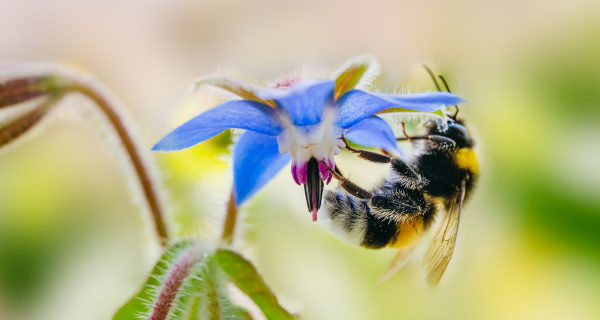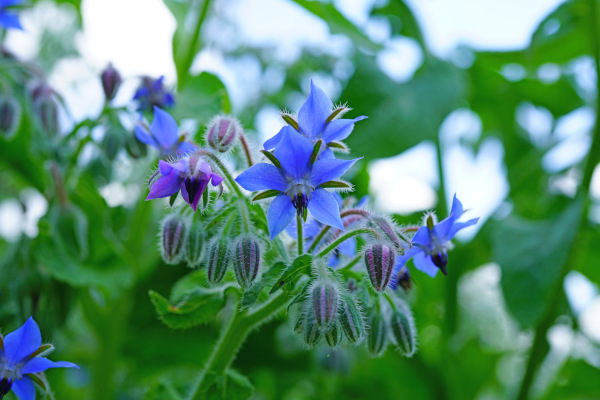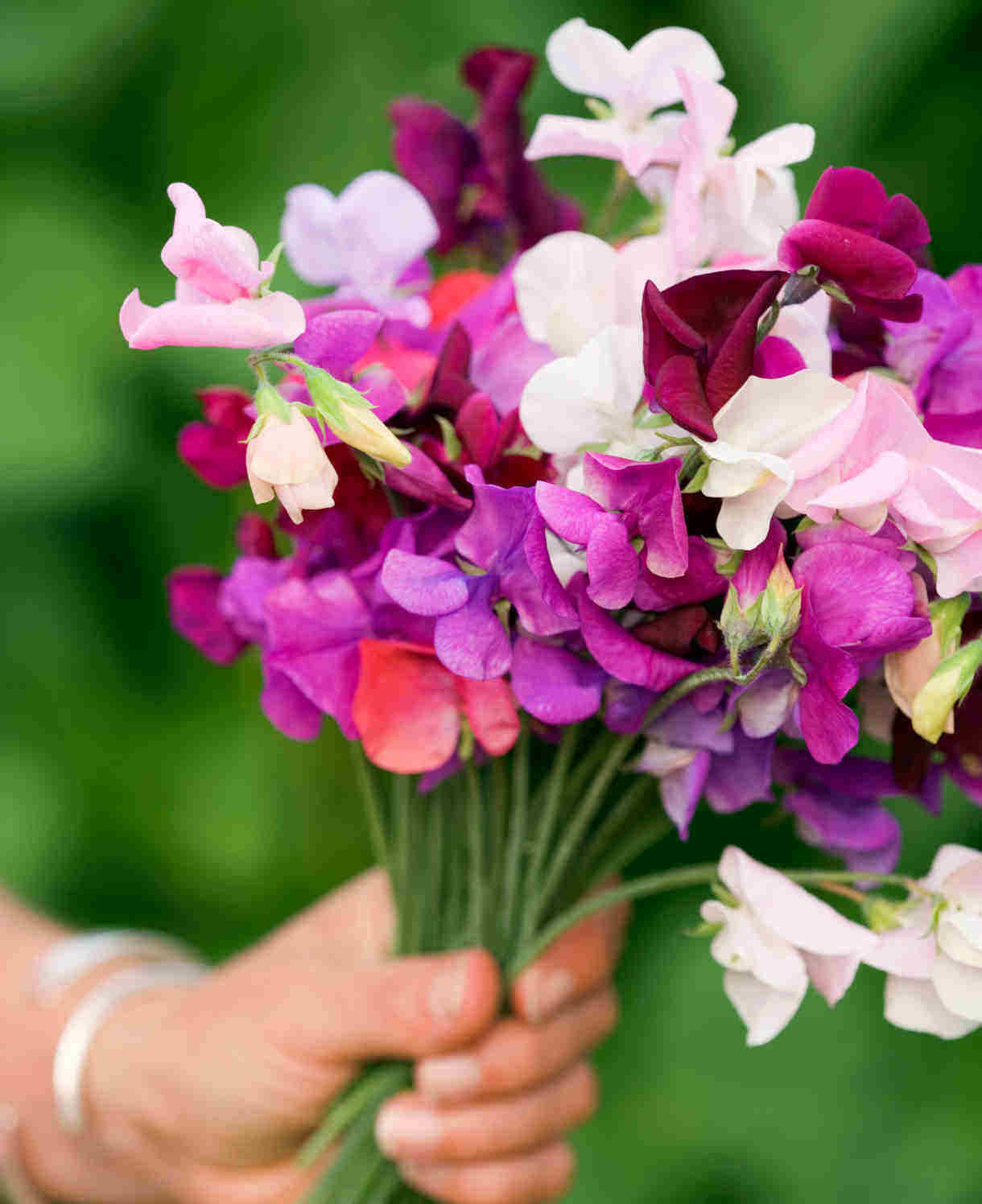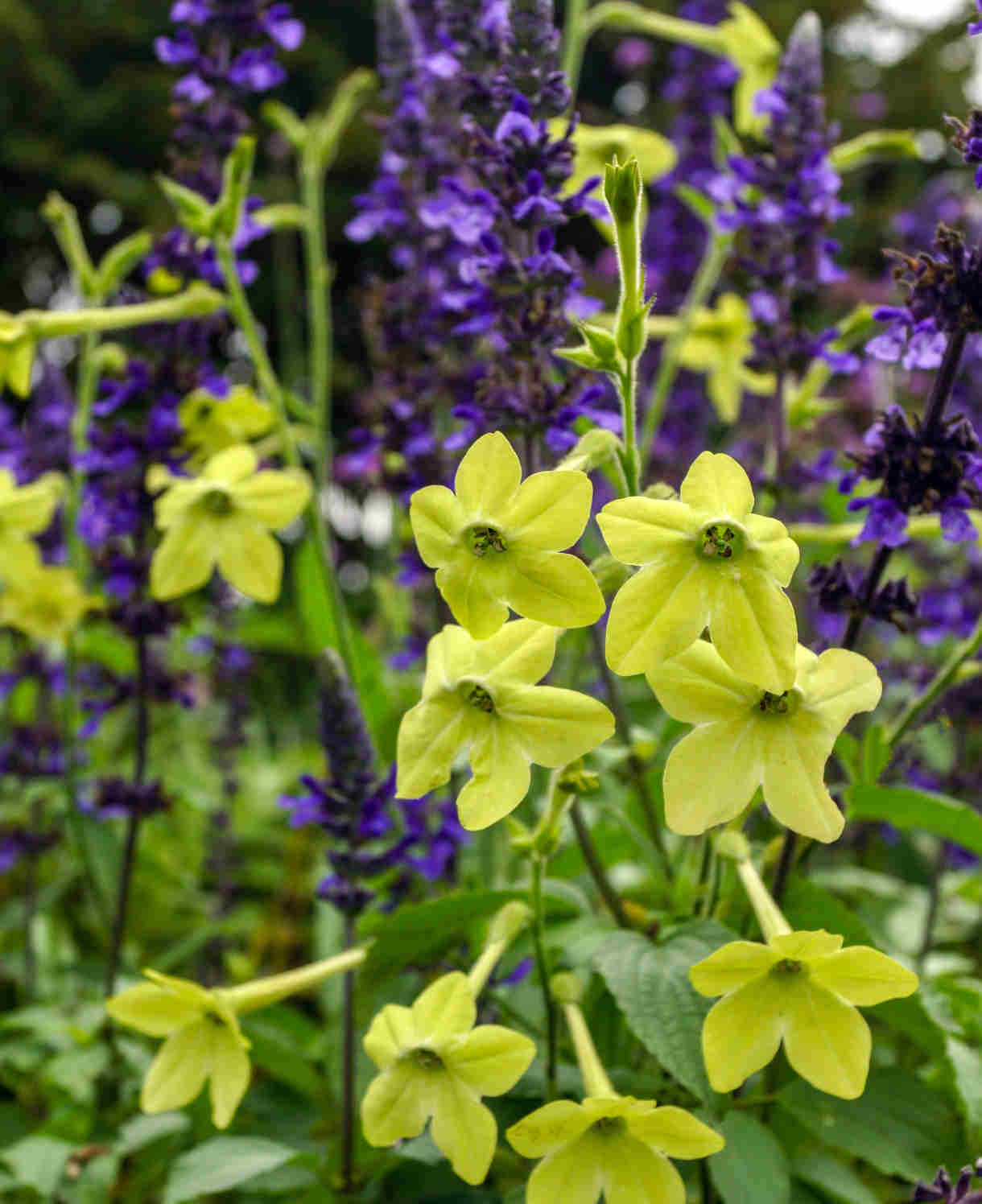How to grow B
There are just two species of this Mediterranean plant more commonly known as borage. The most widely cultivated is Borago officinalis – an annual grown for its profusion of starry, sky-blue flowers and easy, robust nature. Lesser known and grown, though equally as beautiful, is the short-lived perennial species B. pygmaea; a smaller, creeping plant also known as bell-flowered borage. This appears to be one of those plants the experts haven’t quite agreed on yet, as it also has an alternative species name of B. laxiflora.

Key Information
Position
Soil Conditions
Hardiness


Where & when to plant Borago
We offer annual borage as young plants in spring. Aim to get these planted out as the soil begins to warm up in April to May. If they arrive during a spell of very cold or wet weather, instead pot into 9cm containers filled with a well-draining compost mix and grow on in a sheltered environment until more favourable conditions arrive. A coldframe, unheated greenhouse, conservatory, sunny porch, or bright windowsill are all ideal.
Perennial borage are usually sold as potted plants throughout the growing season, though best results are to be had from an autumn or spring planting. An autumn planting can be done by those gardening in mild conditions (and broadly speaking, this is the southern half of the UK). For those liable to cold winters, it is best to wait until spring (generally the northern half of the UK). Planting can also be carried out in summer, though be prepared to water regularly.
Borage is a popular plant for vegetable and herb gardens, for several key reasons:
- Its flowers are edible with a fresh, cucumber-like flavour, and can be used to garnish drinks, salads, and baking.
- The flowers are nectar-rich and highly effective at attracting beneficial pollinators towards other crops.
- It is a host plant for blackfly, and therefore a good sacrificial companion plant to grow alongside broad beans.
Borage can also be grown as part of a wildflower meadow, and makes an excellent gap filler in an informal cottage garden or wildlife-friendly planting scheme. Container-growing is another option – the perennial species is particularly well suited to this due to its dainty, compact size, though annual borage can be grown in this way too. Wherever it is grown, borage can be expected to self-seed readily if spent flowerheads are left intact.
How to plant Borago
- For planting in the garden, dig the soil area removing any large stones and weeds and breaking up any lumps. You don’t have to improve the soil with organic matter such as manure or garden compost, though it will give you larger plants if you do.
- Rake level and firm with your heels. Rake level again.
- Water plants well and allow to drain before planting.
- A good tip is to dig a hole twice the size of the root-ball. Fill with water and allow to drain before placing in the plant.
- Place the plant in the hole, ensuring the top of the root ball sits level with the surface of the soil. Too low and the plant may rot, too high and the roots can dry out.
- Backfill with soil and firm in gently with your foot.
- Soak well with water.
- Mulch around the base with well-rotted organic matter.
- For planting in containers, first choose an appropriately sized pot. For annual borage, a pot of at least 30cm diameter will be needed to support the tall and weighty top growth. Ensure there are plenty of drainage holes in the bottom.
- If you are using a large or heavy pot, it can be a good idea to fill and plant it in situ to save yourself the trouble of moving once full.
- Use a good quality potting compost with some horticultural grit mixed in and, if not already present (check the labelling on the bag) some slow-release fertiliser granules.
- Start by partially filling the pot with compost; enough so that when placed on it the upper surface of the root ball is about 3cm lower than the top of the pot.
- Fill around the plant with compost, firming down with your fingers then adding a little more so it is held tight.
- Pick up the container (if you can!) and lightly tap on the potting bench or ground a few times to help further settle the compost around the plant.
- Soak well with water.
- A mulch with horticultural grit will look attractive and help to prevent a ‘cap’ or crust forming on the top of the compost (something container plants can suffer due to the artificial nature of their watering).

What to plant with Borago
For a garden bursting with summer blooms, team annual borage with other classic, colourful garden annuals such as cosmos, sunflower, sweet pea, and nicotiana. Use these to plug any gaps in borders, fill empty containers, or create a beautiful and beneficial floral element to allotments and veg patches.



How to care for Borago
Pruning and Deadheading
Annual borage can start to look tatty and tired by August. A good tip is to pull it up at this stage and remove to the compost heap, allowing surrounding seedlings (almost certain to be there) to replace it. These should grow up quickly and provide a fresh burst of flowers, which can then last until the first frosts.
Perennial borage should be cut down to just above ground level in autumn and can be expected to regrow the following spring.
There’s no need to deadhead these naturally floriferous plants, though if their tendency to sow themselves around is likely to be a nuisance simply remove spent flower stems before they have the chance to produce seeds.
Watering
Borage in the ground should be given a good watering in on planting, then should be self-sufficient in all but the hottest, driest weather. Having said this, keeping the soil consistently moist will result in larger plants.
Borage in a container requires regular watering throughout the growing season. To avoid overwatering (borage dislikes sitting in soggy compost), a good rule of thumb is to allow the top couple of centimetres to dry out between soakings. To check this, wiggle your finger down into the compost until you feel moisture. Be aware that in the height of summer containers can need watering every day, especially smaller ones.
Feeding
Borage is not a hungry plant and on healthy, fertile soil shouldn’t require feeding to perform well.
If you garden on particularly poor or sandy soil, applying a general-purpose granular feed to the surface of the soil and lightly working it in can provide a welcome boost. This is known as a top dress and should be done in spring.
Container-grown plants are different as they rely solely on the gardener for nutrition. Get off to a flying start by making sure you use a good quality compost with slow-release granules mixed in. These generally provide nutrients for around 6 to 8 weeks, after which a liquid feed every 4 weeks until the end of the growing season will ensure a healthy, thriving plant.
Cold Protection
Perennial borage is hardy enough to withstand winter throughout most of the UK without the need for any special attention. Simply avoid planting anywhere prone to winter waterlogging.
Winter protection is of course irrelevant to annual borage, which is simply removed to the compost heap in autumn.
Pests and Diseases
Borage doesn’t tend to suffer from any serious problems, though can be susceptible to a fungal disease known as powdery mildew. This appears as a white, powder-like coating on foliage and is generally a sign that the plant is stressed – usually through lack of water, though other causes can include poor airflow, over fertilizing, or insufficient sunlight.
Prune off and dispose of any affected leaves, keep well-watered, and thin out surrounding plants to improve airflow and light levels. Do not be tempted to give the plant extra feed, as this will generate an excess of soft, new growth which is particularly susceptible to the fungus.
Another issue can be blackfly (aphid). As always, our advice is that these are part of a balanced garden ecosystem and the best approach is to leave them to their natural predators (e.g. birds, ladybirds, and wasps). When numbers are so large, however, that their feeding starts to inhibit and disfigure growth, you may feel it necessary to take action. Regularly blasting off with a hose or wiping away with a cloth or piece of kitchen paper can help to keep numbers down without harming other members of the ecosystem.
How to propagate Borago
Annual borage is very easy to grow from seed, and in fact a natural propensity to self-sow means the best way to ensure its continued presence in the garden is to leave it to it! By this we mean leaving plants intact until their seeds have ripened and dispersed, along with taking care not to weed seedlings out when tidying the area.
If you’d like to propagate new plants to use elsewhere, collect and sow the seeds as follows:
- Seeds are typically ready for collecting in mid to late summer when they’ve turned hard and black.
- Snip the seedheads from the plant using scissors or secateurs. Try to do this in dry conditions, and shake the seeds into a small, labelled paper bag or envelope. Store somewhere cool and dry until it is time to sow the following spring.
- In April, fill a seed tray or small pot with a well-draining compost mix, compressing the surface lightly with a flat piece of wood or the bottom of another pot.
- Sprinkle the seeds evenly over the surface of the compost.
- Use a garden sieve to cover with a fine layer of compost.
- Water the soil gently with a fine spray until it is evenly moist but not waterlogged.
- Place the seed tray or pots anywhere light and protected, such as a windowsill, coldframe, or greenhouse.
- When the seedlings have grown large enough to handle, plant out into the garden following our ‘How to plant borage’ section above.
You can also sow seeds directly into the soil in April.
Once it has reached a good size, perennial borage can be divided in early spring. As well as producing new plants, this has the added benefit of reinvigorating existing clumps which can otherwise be fairly short-lived.
- Choose a day when the soil is not frozen or waterlogged.
- Dig the plant out of the ground.
- Shake off any excess soil.
- Separate the plant into sections using either swift, cutting blows with a sharp spade, or two forks inserted back-to-back with tines touching, handles then pushed together to prise the plant apart.
- Discard old, damaged or surplus pieces keeping healthy, vigorous material.
- Replant or pot up selected pieces as required.
* Many plants carry Plant Breeders Rights and cannot be propagated for commercial purposes.
Common Borago questions
- Does borage grow back every year/ is borage a perennial or annual?
The individual plants of annual borage live for one year only, however if allowed to set seed (i.e., left intact until autumn) new plants can be expected to pop up in the same spot the following year.
Perennial borage is a short-lived perennial which lasts for several years; dying back each autumn and regrowing each spring. - How long does it take to grow borage?
Borage is a spectacularly fast-growing plant and tends to reach full flowering maturity approximately 8 weeks after sowing.




